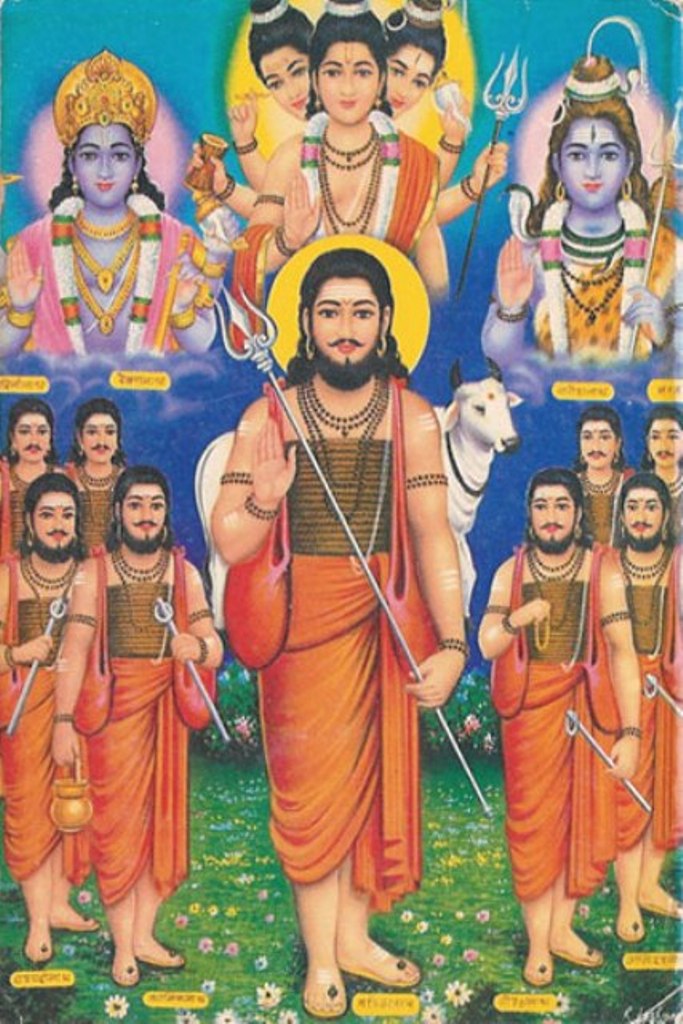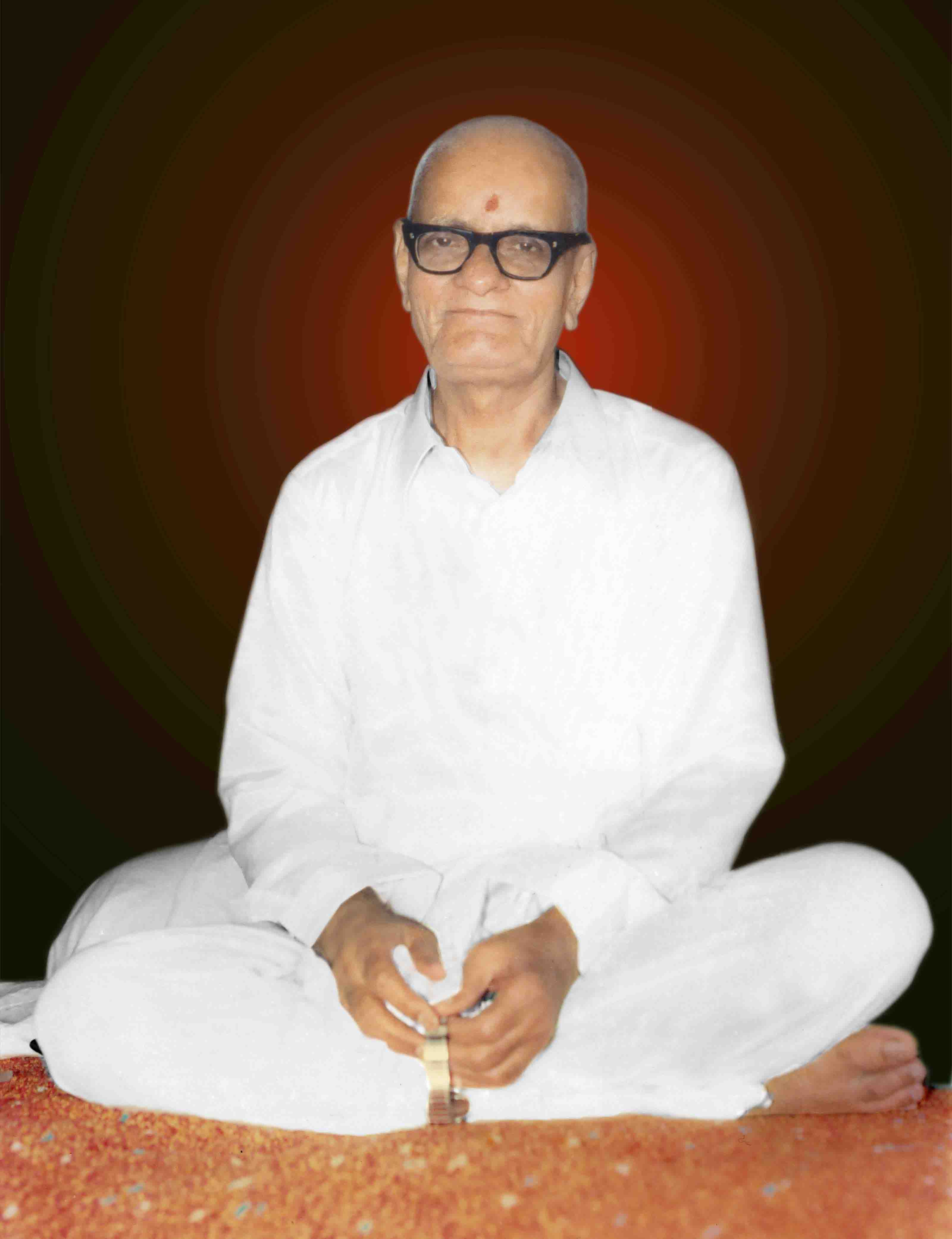|
Siddharameshwar
Sri Siddharameshwar Maharaj (1888–1936) was a guru in the Inchagiri Sampradaya founded by his guru Bhausaheb Maharaj, a branch of the Navnath Sampradaya, the 'Nine Masters' tradition in India. His disciples included Nath teachers Nisargadatta Maharaj, Ranjit Maharaj, Kaadsiddheshwar, and Ganapatrao Maharaj Kannur. Biography Siddharameshwar was born in 1888 in the village Pathri, Solapur, India. Since his childhood, he was very intelligent and had very sharp imbibe abilities. In 1906, he was initiated by his guru 'Shri Bhausaheb Maharaj' in Inchagiri in Karnataka India, who taught mantra meditation as the way to reach Final Reality. He was one of the contemporaries of Sri Ramana Maharshi. In 1920, Siddharameshwar started to set out on "the Bird's Path", the fast way to attain realization, six years after Bhauhaseb maharaj had died. His fellow-students opposed, but eventually he succeeded by himself. Siddharameshwar died on 9 November 1936 ( Ekadashi, 11th day in the later ... [...More Info...] [...Related Items...] OR: [Wikipedia] [Google] [Baidu] |
Inchagiri Sampradaya
The Inchagiri Sampradaya, also known as Nimbargi Sampradaya, is a lineage of Hindu Navnath and Lingayat Guru, teachers from Maharashtra which was started by Bhausaheb Maharaj. It is inspired by Sant Mat teachers as Namdev, Ravidas, Raidas and Kabir Das, Kabir. The Inchagiri Sampradaya has become well known throughout the western world due to the popularity of Nisargadatta Maharaj. History Navnath Dattatreya The mythological origins of the Inchagiri Sampradaya are ascribed to Dattatreya, Adiguru Shri Dattatreya. He initiated the Navnath, Navanaths, the Holy Nine Gurus, and the Navnath, Navanath Sampraday. Revananath – Siddhagiri Math (Kaneri Math) One of those Navnaths was Revanath, the 7th or 8th Navnath. Revanath settled on the Siddhgiri hill for ascetic practice, living on whatever the jungle, gave him. He became famous as Kaadhsiddheshwar, "the one who attained supreme realization in a forest". Revananath is considered to have established the Siddhagiri Gramjivan ... [...More Info...] [...Related Items...] OR: [Wikipedia] [Google] [Baidu] |
Sarira (Vedanta)
According to Sarira Traya, the Doctrine of the Three bodies in Hinduism, the human being is composed of three shariras or "bodies" emanating from Brahman by avidya, "ignorance" or "nescience". They are often equated with the five koshas (sheaths), which cover the atman. The ''Three Bodies Doctrine'' is an essential doctrine in Indian philosophy and religion, especially Yoga, Advaita Vedanta, Tantra and Shaivism. The Three Bodies Karana sarira – causal body ''Karana sarira'' or the causal body is merely the cause or seed of the subtle body and the gross body. It has no other function than being the seed of the subtle and the gross body. It is ''nirvikalpa rupam'', "undifferentiated form". It originates with ''avidya'', "ignorance" or "nescience" of the real identity of the atman, instead giving birth to the notion of ''jiva''. Swami Sivananda characterizes the causal body as "The beginningless ignorance that is indescribable". Siddharameshwar Maharaj, the guru of Nisargadat ... [...More Info...] [...Related Items...] OR: [Wikipedia] [Google] [Baidu] |
Ganapatrao Maharaj Kannur
Shri Samartha Sadaguru Ganapatrao Maharaj Kannur (1909–2004) was an Indian guru in the Inchegeri Sampradaya. Biography Early years Kannur was born on 18 September 1909 on the day of Ganesh Chaturthi (Bhadrapad Shukla Chaturthi), in a Deshastha Brahmin family of Smt Saraswatibai & Shrimant Shivrampant Kannur, in the small village Kannur, located in the Bijapur district of Karnataka, India. He had his primary and high-school education in Bijapur. He graduated in 1932, earning a B.Sc. (mathematics and physics) degree from Fergusson College, Pune. Sri Siddharameshwar Maharaj Since his early childhood days, Kannur had a great inclination towards spirituality. At the age of 13 he was blessed and initiated by Sri S.S. Siddharameshwar Maharaj, who also accepted him as his disciple and guided him to the path of self attainment. Maharaj had given stringent directives to few of his selfless disciples: to wear ochre robes, to be devoted towards '' sadhana'' and make it the sole ... [...More Info...] [...Related Items...] OR: [Wikipedia] [Google] [Baidu] |
Nisargadatta Maharaj
Nisargadatta Maharaj (born Maruti Shivrampant Kambli; 17 April 1897 – 8 September 1981) was an Indian guru of nondualism, belonging to the Inchagiri Sampradaya, a lineage of teachers from the Navnath Sampradaya and Lingayat Shaivism. The publication in 1973 of '' I Am That'', an English translation of his talks in Marathi by Maurice Frydman, brought him worldwide recognition and followers, especially from North America and Europe. Biography Early life Nisargadatta was born on 17 April 1897 to Shivrampant Kambli and Parvati bai, in Bombay. The day was also ''Hanuman Jayanti'', the birthday of Hanuman, hence the boy was named 'Maruti', after him. His parents were followers of the Varkari sampradaya, an egalitarian Vaishnavite bhakti tradition which worships Vithoba. His father, Shivrampant, worked as a domestic servant in Mumbai and later became a petty farmer in Kandalgaon. Maruti Shivrampant Kambli was brought up in Kandalgaon, a small village in the Sindhudurga d ... [...More Info...] [...Related Items...] OR: [Wikipedia] [Google] [Baidu] |
Bhausaheb Maharaj
Bhausaheb Maharaj ( - c. 1914) was the founder of the Inchegeri Sampradaya, to which the well-known Indian guru Nisargadatta Maharaj belonged. Biography Background Bhausaheb Maharaj was born in 1843 as Venkatesh Khanderao Deshpande. Bhausaheb Maharaj belonged to the Deshastha Brahmin caste, the same caste to which the thirteenth century Varkari saint and philosopher Dnyaneshwar belonged, the 16th century sant Eknath, and the 17th century saint and spiritual poet Samarth Ramdas. Dnyaneshwar was universally acclaimed for his commentary on the Bhagvad Gita. Eknath published an extensive poem called the ''Eknathi Bhagwat'' in the 16th century. Other works of Eknath include the ''Bhavartha Ramayana'', the ''Rukmini Swayamwara'' and the ''Swatma Sukha''. Samarth Ramdas, who was also the spiritual adviser to Shivaji, wrote the ''Dasbodh''. Spiritual life According to Kotnis, Bhausaheb Maharj was looked upon as the reincarnation of Sant Tukaram (1577–1650), a prominent Varkari Sant ... [...More Info...] [...Related Items...] OR: [Wikipedia] [Google] [Baidu] |
Ranjit Maharaj
''Sri Ranjit Maharaj'' (4 January 1913 – 15 November 2000) was an Indian spiritual teacher in the Navnath Inchegeri Sampradaya tradition, and disciple of Siddharameshwar Maharaj. Biography Ranjit Maharaj was born on 4 January, 1913. His father died when he was 6 years old. In 1924, he met Siddharameshwar Maharaj. The following year he was initiated by Siddharameshwar Maharaj. In 1934, at the age of 21, he got initiated into monkhood. Only in 1983, at the age of 70, he initiated his first disciple, Shri Siddharameshwar Maharaj's granddaughter-in-law. Hereafter, he started to attract an international following. In 1996, he was invited to visit Germany, France and USA. In the following years, he visited these countries several times, and also the UK, Switzerland and Spain also, until 2000, when he died. Inchegeri Sampradaya Ranjit Maharaj belongs to the Inchegiri Sampradaya, a lineage of teachers belonging to the Navnath The Navanath (हिंदी - नवनाथ), also s ... [...More Info...] [...Related Items...] OR: [Wikipedia] [Google] [Baidu] |
Subitism
The term subitism points to sudden awakening, the idea that insight into Buddha-nature, or the nature of mind, is "sudden," c.q. "in one glance," "uncovered all together," or "together, completely, simultaneously," in contrast to "successively or being uncovered one after the other." It may be posited as opposite to gradualism, the original Buddhist approach which says that following the dharma can be achieved only step by step, through an arduous practice. Etymology The application of the term "subitism" to Buddhism is derived from the French '' illumination subite'' (sudden awakening), contrasting with 'illumination graduelle' (gradual awakening). It gained currency in this use in English from the work of sinologist Paul Demiéville. His 1947 work 'Mirror of the Mind' was widely read in the U.S. It inaugurated a series by him on subitism and gradualism. The Chinese term ''tun'', as used in ''tun- wu'', translated as "subite," sudden, has a broader meaning than "sudden." It is ... [...More Info...] [...Related Items...] OR: [Wikipedia] [Google] [Baidu] |
Kaadsiddheshwar
Shri Samarth Muppin Kaadsiddheswar Maharaj (April 23, 1905 – August 16, 2001) was one of the great gurus in the Navnath tradition of Hindu philosophy. He was a disciple of Shri Samarth Siddharameshwar Maharaj, disciple of Shri Samarth Bhausaheb Maharaj, disciple of Shri Gurulingajangam Maharaj (Shri Nimbargi Maharaj), disciple of the 22nd Shri Samarth Muppin Kaadsiddheswar Maharaj. Biography Kaadsiddheswar was born on April 23, 1905 (Chaitra Sankashti day) in Linganoor village, Kolhapur district, Maharashtra state, India. His father's name was Shaigauda Patil, and he was named Jaigauda Patil. His living descendant is Indumati Magdum (daughter of his real sister). Indumati is 85 and lives with her son Sanjeev, daughter in law Jayashree and grand daughter Krupa in Nagala Park, Kolhapur. He was formally adopted by the 25th Virupaksha Kaadeshwar of the Kaneri Math, Lingayat Parampara, and invested as the 26th Mathadheepati of the (Siddhagiri) Kaneri Math, Lingayat Paramp ... [...More Info...] [...Related Items...] OR: [Wikipedia] [Google] [Baidu] |
Subtle Body
A subtle body is a "quasi material" aspect of the human body, being neither solely physical nor solely spiritual, according to various esoteric, occult, and mystical teachings. This contrasts with the mind–body dualism that has dominated Western thought. The subtle body is important in the Taoism of China and Dharmic religions such as Hinduism, Buddhism, and Jainism, mainly in the branches which focus on tantra and yoga, where it is known as the ''Sūkṣma-śarīra'' ( sa, सूक्ष्म शरीर). However, while mostly associated with Asian cultures, non-dualistic approaches to the mind and body are found in many parts of the world. Subtle body concepts and practices can be identified as early as 2nd century BCE in Taoist texts found in the Mawangdui tombs. Although "evidently present" in Indian thought as early as the 4th to 1st century BCE when the Taittiriya Upanishad describes the Panchakoshas, a series of five interpenetrating sheaths of the body. A fully ... [...More Info...] [...Related Items...] OR: [Wikipedia] [Google] [Baidu] |
Vedanta
''Vedanta'' (; sa, वेदान्त, ), also ''Uttara Mīmāṃsā'', is one of the six (''āstika'') schools of Hindu philosophy. Literally meaning "end of the Vedas", Vedanta reflects ideas that emerged from, or were aligned with, the speculations and philosophies contained in the Upanishads, specifically, knowledge and liberation. Vedanta contains many sub-traditions, all of which are based on a common group of texts called the "Three Sources" ('' prasthānatrayī''): ''the Upanishads'', the ''Brahma Sutras'' and the '' Bhagavad Gita''. All Vedanta traditions contain extensive discussions on ontology, soteriology and epistemology, though there is much disagreement among the various schools. The main traditions of Vedanta are: ''Advaita'' (non-dualism), ''Bhedabheda'' (difference and non-difference), '' Suddhadvaita'' (pure non-dualism), ''Tattvavada ( Dvaita)'' (dualism), and ''Vishishtadvaita'' (qualified non-dualism). Modern developments in Vedanta include Neo-V ... [...More Info...] [...Related Items...] OR: [Wikipedia] [Google] [Baidu] |
Kosha
A ''kosha'' (also ''kosa''; Sanskrit कोश, IAST: ), usually rendered "sheath", is a covering of the ''Atman'', or Self according to Vedantic philosophy. There are five ''koshas'' (Panchakoshas; ; the five sheaths), and they are often visualised as the layers of an onion in the subtle body. The ''Tvam'' ("Thou") ''padartha'' of the ''Mahavakya'' ''Tat Tvam Asi'' is determined by the analysis of ''Panchakoshas'' that are not the ''atman''. ''Panchakoshas'' are discussed in the ''Brahmanandavalli'' Chapter of Taittiriya Upanishad which is a part of the Taittiriya Samhita of the Krishna Yajur Veda and in which particular chapter is discussed ways and means to achieve Brahman. It gives a detailed description of the dimensions of human personality or the dimensions of the Self. Atman The '' Sruti'' declares that human birth, by divine grace, is meant to strive to know and understand the ''atman''. The knowledge and understanding of the ''atman'' invariably results in ''Jiwan ... [...More Info...] [...Related Items...] OR: [Wikipedia] [Google] [Baidu] |



.jpg)
